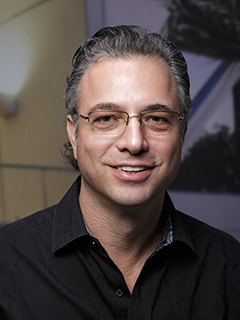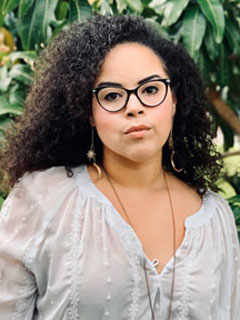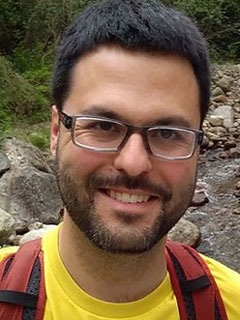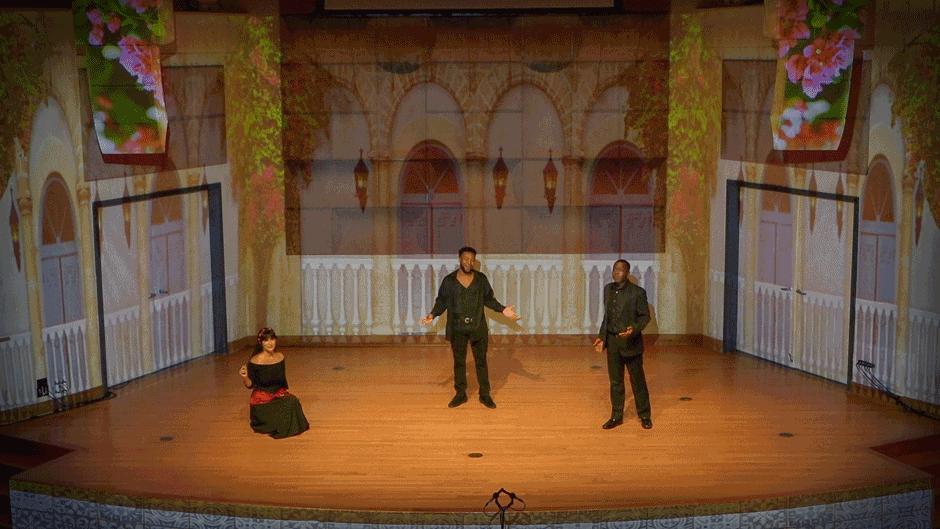When freshman Emma Beers entered the Victor E. Clarke Recital Hall recently to see this fall’s production of “Opera Scenes,” she expected to see some classmates performing pieces from several different operas with no set behind them.
Instead, she and audience members were transported to a stained-glass cathedral in France, for an act from the opera “Manon.” They also spent time in a Scottish castle, complete with fireplaces and dancing digital flames, while student singers graced the stage for an excerpt of the opera “Lucia di Lammermoor.” And Beers’ favorite: a performance from the opera “Pagliacci,” where two vocalists were surrounded by a massive tent as they regaled the audience about their secret love affair.

“It added so much, and made me want to join this performance as soon as possible,” she said.
Beers and dozens of others in the sold-out audience experienced the first performance at the University of Miami Frost School of Music to utilize the newly installed digital “projection mapping” technology to create a more engaging backdrop onstage with images and moving pictures. In all, there were 13 different opera scenes in the production, so viewers had to transition their attention quickly and the visuals helped them do this, Beers pointed out.
“Not everyone is super familiar with these operas in different languages, so [the projections and the supertitles] really helped to convey what they are singing about and to tell the story,” said Beers, a music education major. “It gives you the feel of a fully staged opera, even in just a few minutes.”
Last summer, Clarke Recital Hall got a suite of new equipment, including high quality projectors that made it possible for projection mapping to enhance performances, said Jeffrey Buchman, assistant professor of vocal performance and stage director for the Frost Opera Theater program.
“I saw this as a great way to transform the way we do ‘Opera Scenes,’ so we could really place the performer in a scenic world, to bring them and the audience into the place and time of the piece,” he said. “And I love to reach out into the University’s community of technical and creative faculty, to see how we can up our game by collaborating.”
Buchman had a feeling that colleagues at the School of Communication may be able to help him get this off the ground. So last summer, Buchman began working with interactive media lecturers Zevensuy Rodriguez and Lorena Lopez to explore using projection mapping in the “Opera Scenes” production.
During the course of five months, the faculty members met weekly to discuss ideas for the different opera pieces. Lopez and Rodriguez mapped out the performance space in 3D and brainstormed how they would project images and animations across the stage to bring the operas to life. For both interactive media lecturers, it was their first time creating projection maps, but both Lopez and Rodriguez have an interest in using technology to enrich performances.

“A lot of operas are very old, but through this project, we got the chance to provide a modernized interpretation of them, which was a really interesting experience that I found fascinating,” said Rodriguez, who has worked with performance artists, retailers, and filmmakers to offer more immersive experiences with technology.
Next, the lecturers gathered images that would match the content of the operas and considered how they could embellish the “set” digitally. For example, in one scene of Mozart’s “The Marriage of Figaro,” there are two women discussing a letter, so Lopez and Rodriguez worked to create an animated version of the letter that was being written in the sky as the characters sang.
“The beauty of projection mapping is you can take the architecture of a space and repurpose it to become functional storytelling objects, so we decided to convert doors into fireplaces and to use speakers as chandeliers,” Rodriguez explained.
Lopez, who started working on costume and immersive set design in college, and then professionally, at the Miami Children’s Museum, said she was pleased with the final product.
“It was great to be able to transform a space so quickly,” she said. “The amount of production value that goes into creating a physical set that is often quickly put away is tremendous, so this could be a more cost-efficient way to enhance scenic design.”
Professor Alan Johnson, music conductor and director of the Frost Opera Theater, worked closely with the 35 student vocalists and Buchman to produce “Opera Scenes.” He said both the performers and the audience appreciated the digitally enhanced set.
“It’s the wave of the future and has been for many years to incorporate video projection as part of scenic design in opera,” he said. “But projection mapping using this kind of technology is pretty new, and we’re excited to add it to our operatic arsenal.”

Rodriguez, Lopez, and Buchman hope to build upon this year’s show to offer more elaborate, modern scenes next year. The interactive media faculty members also want to offer projection mapping through a class, so that they can teach students how to produce interactive scenes in a variety of performance venues.
“The goal in this case was to showcase the operas, but a goal for the future could be, ‘How can we create a digital space where the artist or performer could interact with the digital projection, to further embellish the story?’ ” Rodriguez said.
Watch the performance: Opera Scenes—Frost Opera Theater

